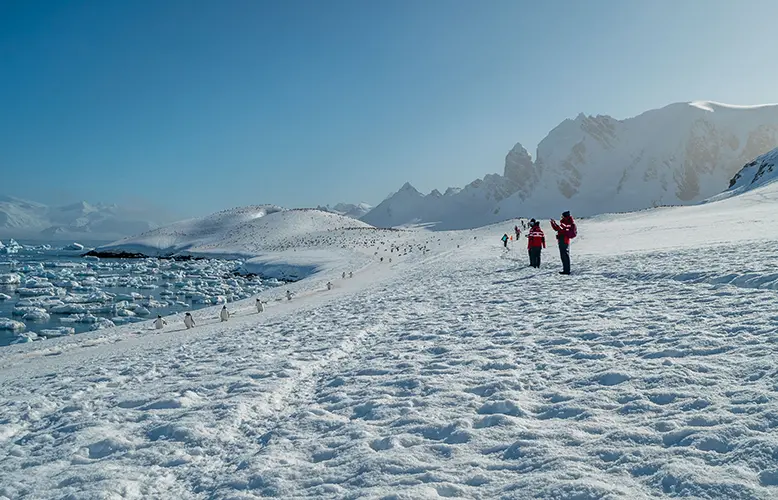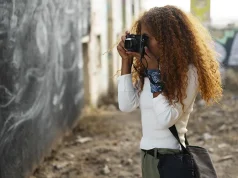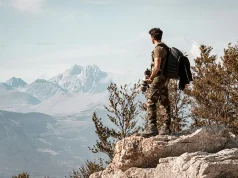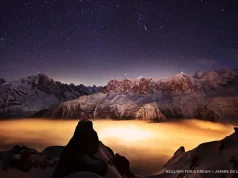Having visited the likes of Patagonia, Svalbard and Greenland, Burnham Arlidge admits that his recent journey to the Falklands, South Georgia and Antarctica was the best photography trip he’s ever been on.
Burnham says: “Working as a photographer, I’ve been lucky enough to visit some of the most incredible locations on Earth. I’ve stalked Polar Bears in the Canadian Arctic, gazed at the northern lights in Greenland, and wondered at hanging glaciers in Patagonia. Few places on the planet, however, have left me with a gallery of photographs quite like this trip.
“The composition options, the lights, the dramatic landscapes; it’s just unbelievable.”
He took a South Georgia, Antarctica and Falklands Explorer trip provided by Swoop Antarctica. The 21-day adventure takes travellers on a small ship cruise to remote and underexplored areas of Antarctica, South Georgia and The Falkland Islands.
“The size of the vessel frees you to dock up in tight, isolated bays where no one has been in years. You don’t have a set itinerary or know which precise inlet you’ll be heading to. Instead, you sail with the weather and it dictates where you dock.

“Of course, you know the region you are heading to and the number of days you will be staying there but not the exact location you’ll be. As a result, you get up close to undisturbed wildlife and landscapes that you would never otherwise see.”
Highlights of the three-week trip include seeing the largest king penguin colonies on the planet, zodiac cruising through crinkling brash ice in Antarctica and visiting the farms in the westernmost settled outposts in the Falklands that have been owned by families for hundreds of years.
Your journey begins with a flight to the world’s southernmost city, Ushuaia. Upon arrival, you’ll be whisked away to a five-star hotel overlooking the Beagle Channel where you can rest and recharge from your travels for the next two nights.
After a leisure day in Ushuaia, during which you can visit Tierra del Fuego National Park, sample the local king crab regional speciality or explore the city and its hiking routes, the real adventure begins as you board the small ship.
The vessel’s expedition team and officers greet and welcome you onto the 139-passenger ship which features state-of-the-art stabilisers and sleek, spacious suites.
After a fine dining experience, sit down and take snapshots of the glorious mountain scenery as you set sail along the Beagle Channel, passing Magellanic penguins, Rock Cormorants, and sea lion colonies en route to the Falkland Islands.

Drift by icebergs along the Southern Ocean the next day, accompanied by albatrosses, prions, and petrels as they follow the vessel. The expedition team keeps a careful watch on the surroundings, ever ready to highlight whales and dolphins along the way.
You will also be invited to an informative onboard presentation on the wildlife, history and geology of the Falkland Islands and the Southern Ocean. Additionally, you can actively engage by participating in seabird sighting surveys or contributing to the collection of salinity samples and weather data.
The fifth day is spent exploring the westernmost settled outposts in the Falklands which are home to remote farms that have been owned by families for seven generations. The wild, windswept landscape is devoid of trees and completely silent and undisturbed, bar the lively vibrant local wildlife.
Sheep graze alongside albatrosses and rockhopper, king, and macaroni penguin rookeries, while Caracas fly overhead and upland geese graze by the curling waves of the white sand beaches.
“It was surreal – it felt like Hawaii but with penguins everywhere. My favourite shot I took here was one of the penguins on the beach. It looked like they were holidaying in the Caribbean.”
While here, you can visit homesteads and gain unique insights into the lives of those living in this remote area over a cup of tea and cakes.
The next day, you will be taken to Stanley, the capital city of the Falkland Islands. Explore the unique metropolis on foot, popping into shops selling locally-made wool garments, visiting the museum and investigating the lively pub scene. You can also spot sea lions and dolphins in the harbour and bird life by Gypsy Cove.
Over the next two days, you will travel east across the Antarctic Convergence on your way to South Georgia. You’ll be able to spot wildlife from the ship’s deck and listen to fascinating presentations on the region’s history.
Come day nine, you reach South Georgia. Nicknamed the Serengeti of the South, it is famed for its high populations of penguins and seals. Its marine ecosystem is one of the world’s densest examples of biodiversity.
“I’ve been close to wildlife before, particularly in the Galapagos Islands but the backdrop of South Georgia is so dramatic. We’re talking towering ice-peak mountains in close proximity to thousands of penguins. It makes for incredible photo after incredible photo. And the light there is constantly changing. No matter what time of day you go ashore, you’re guaranteed something new.
“The wildlife is magnificent here. Even just on the beaches, you’re getting huge elephant seals, aggressive fur seals, macaroni penguins, albatrosses, petrels, skuas, and gulls everywhere. It’s like walking through a nature documentary. It’s something you really have to see to believe.”
You’ll also come across hundreds of thousands of king penguins of all ages, from fuzzy chicks to mature adults.
The region’s unique location is to thank for its sensational wildlife scene. It is situated within the Antarctic Convergence but outside the limit of the yearly sea ice. Consequently, the 3,755 square kilometre island is home to tens of millions of breeding penguins, seals and seabirds.
Spend the next three days snapping sensational shots of the wildlife, towering mountains, immense glaciers, rugged coastline and tabular icebergs.
You can visit the Grytviken whaling station during your time in South Georgia. It is the first shore-based whaling station for Antarctic whaling. You’ll also be taken to the Norwegian seamen’s church, the active British Antarctic Survey station and the tiny graveyard where the legendary polar explorer, Sir Ernest Shackleton, is buried.
Over the next two days, you gradually navigate through a growing number of icebergs as you journey southward aboard the vessel, heading towards the trip’s final visit destination: The Antarctic Peninsula and the South Shetland Islands. Informative presentations and wildlife watches will keep you entertained along the way.
As you approach the Antarctic Peninsula, your expedition leader and captain will draw up a three-night itinerary based on the weather and ice conditions. Entering the region from the east, you come across the northern boundary of the Weddell Sea.
The area is thriving with wildlife, as it marks the point where a large cold body of water rotates clockwise driving cold water and ice north towards South Georgia and the South Orkney Islands. The ocean currents derive nutrients from the deep, feeding countless species of marine animals.
“Antarctica’s landscape is simply alien. Ethereal, beautiful but undeniably strange. It offers such a contrast to The Falklands and South Georgia.
“My favourite moment in Antarctica was when we were on a zodiac cruise to see wildlife. The light was coming through the clouds giving this blue glow. We were just zodiacing through brash ice as it crinkled and crackled below us.”
Drift by tabular icebergs and groups of whales as seabirds soar across the sky above you. Spend the days visiting the most scenic bays and channels of the Peninsula and visiting penguin rookeries of Adelie, Chinstrap and Gentoo.
You’ll also see crabeater, leopard, Antarctic fur and elephant seal wallows, bird colonies and minke, orca and humpback whale feeding areas. After four days, you will begin your two-night homeward journey along Drake Passage back to Ushuaia.
After disembarking on your final day, you will catch an afternoon flight to Buenos Aires.
Burnham has some advice for other photographers thinking about taking the same trip:
“These destinations are on a scale almost unmatched anywhere else on Earth. So, take your time – the wildlife is all around you, you don’t need to rush. Also, get low. The animals are low to the ground so you should be too. Get into their world. Lastly, you don’t need to bring long lenses because the wildlife is always right next to you. Bring wide-angle lenses instead to capture the drama. Finally, be as creative as you can and don’t lose your camera in the water!”





